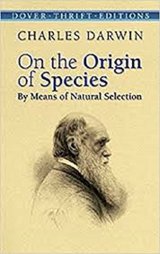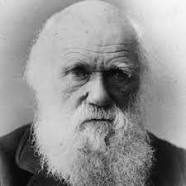On the Origin of Species By Means of Natural Selection Page #7
On the Origin of Species, published on 24 November 1859, is a work of scientific literature by Charles Darwin which is considered to be the foundation of evolutionary biology. Darwin's book introduced the scientific theory that populations evolve over the course of generations through a process of natural selection.
An argument, as it seems to me, of great weight, and applicable in several other cases, is, that the above-specified breeds, though agreeing generally in constitution, habits, voice, colouring, and in most parts of their structure, with the wild rock-pigeon, yet are certainly highly abnormal in other parts of their structure: we may look in vain throughout the whole great family of Columbidae for a beak like that of the English carrier, or that of the short-faced tumbler, or barb; for reversed feathers like those of the jacobin; for a crop like that of the pouter; for tail-feathers like those of the fantail. Hence it must be assumed not only that half-civilized man succeeded in thoroughly domesticating several species, but that he intentionally or by chance picked out extraordinarily abnormal species; and further, that these very species have since all become extinct or unknown. So many strange contingencies seem to me improbable in the highest degree. Some facts in regard to the colouring of pigeons well deserve consideration. The rock-pigeon is of a slaty-blue, and has a white rump (the Indian sub-species, C. intermedia of Strickland, having it bluish); the tail has a terminal dark bar, with the bases of the outer feathers externally edged with white; the wings have two black bars; some semi-domestic breeds and some apparently truly wild breeds have, besides the two black bars, the wings chequered with black. These several marks do not occur together in any other species of the whole family. Now, in every one of the domestic breeds, taking thoroughly well-bred birds, all the above marks, even to the white edging of the outer tail-feathers, sometimes concur perfectly developed. Moreover, when two birds belonging to two distinct breeds are crossed, neither of which is blue or has any of the above-specified marks, the mongrel offspring are very apt suddenly to acquire these characters; for instance, I crossed some uniformly white fantails with some uniformly black barbs, and they produced mottled brown and black birds; these I again crossed together, and one grandchild of the pure white fantail and pure black barb was of as beautiful a blue colour, with the white rump, double black wing-bar, and barred and white-edged tail-feathers, as any wild rock-pigeon! We can understand these facts, on the well-known principle of reversion to ancestral characters, if all the domestic breeds have descended from the rock-pigeon. But if we deny this, we must make one of the two following highly improbable suppositions. Either, firstly, that all the several imagined aboriginal stocks were coloured and marked like the rock-pigeon, although no other existing species is thus coloured and marked, so that in each separate breed there might be a tendency to revert to the very same colours and markings. Or, secondly, that each breed, even the purest, has within a dozen or, at most, within a score of generations, been crossed by the rock-pigeon: I say within a dozen or twenty generations, for we know of no fact countenancing the belief that the child ever reverts to some one ancestor, removed by a greater number of generations. In a breed which has been crossed only once with some distinct breed, the tendency to reversion to any character derived from such cross will naturally become less and less, as in each succeeding generation there will be less of the foreign blood; but when there has been no cross with a distinct breed, and there is a tendency in both parents to revert to a character, which has been lost during some former generation, this tendency, for all that we can see to the contrary, may be transmitted undiminished for an indefinite number of generations. These two distinct cases are often confounded in treatises on inheritance. Lastly, the hybrids or mongrels from between all the domestic breeds of pigeons are perfectly fertile. I can state this from my own observations, purposely made on the most distinct breeds. Now, it is difficult, perhaps impossible, to bring forward one case of the hybrid offspring of two animals CLEARLY DISTINCT being themselves perfectly fertile. Some authors believe that long-continued domestication eliminates this strong tendency to sterility: from the history of the dog I think there is some probability in this hypothesis, if applied to species closely related together, though it is unsupported by a single experiment. But to extend the hypothesis so far as to suppose that species, aboriginally as distinct as carriers, tumblers, pouters, and fantails now are, should yield offspring perfectly fertile, inter se, seems to me rash in the extreme. From these several reasons, namely, the improbability of man having formerly got seven or eight supposed species of pigeons to breed freely under domestication; these supposed species being quite unknown in a wild state, and their becoming nowhere feral; these species having very abnormal characters in certain respects, as compared with all other Columbidae, though so like in most other respects to the rock-pigeon; the blue colour and various marks occasionally appearing in all the breeds, both when kept pure and when crossed; the mongrel offspring being perfectly fertile;--from these several reasons, taken together, I can feel no doubt that all our domestic breeds have descended from the Columba livia with its geographical sub-species. In favour of this view, I may add, firstly, that C. livia, or the rock-pigeon, has been found capable of domestication in Europe and in India; and that it agrees in habits and in a great number of points of structure with all the domestic breeds. Secondly, although an English carrier or short-faced tumbler differs immensely in certain characters from the rock-pigeon, yet by comparing the several sub-breeds of these breeds, more especially those brought from distant countries, we can make an almost perfect series between the extremes of structure. Thirdly, those characters which are mainly distinctive of each breed, for instance the wattle and length of beak of the carrier, the shortness of that of the tumbler, and the number of tail-feathers in the fantail, are in each breed eminently variable; and the explanation of this fact will be obvious when we come to treat of selection. Fourthly, pigeons have been watched, and tended with the utmost care, and loved by many people. They have been domesticated for thousands of years in several quarters of the world; the earliest known record of pigeons is in the fifth Aegyptian dynasty, about 3000 B.C., as was pointed out to me by Professor Lepsius; but Mr. Birch informs me that pigeons are given in a bill of fare in the previous dynasty. In the time of the Romans, as we hear from Pliny, immense prices were given for pigeons; "nay, they are come to this pass, that they can reckon up their pedigree and race." Pigeons were much valued by Akber Khan in India, about the year 1600; never less than 20,000 pigeons were taken with the court. "The monarchs of Iran and Turan sent him some very rare birds;" and, continues the courtly historian, "His Majesty by crossing the breeds, which method was never practised before, has improved them astonishingly." About this same period the Dutch were as eager about pigeons as were the old Romans. The paramount importance of these considerations in explaining the immense amount of variation which pigeons have undergone, will be obvious when we treat of Selection. We shall then, also, see how it is that the breeds so often have a somewhat monstrous character. It is also a most favourable circumstance for the production of distinct breeds, that male and female pigeons can be easily mated for life; and thus different breeds can be kept together in the same aviary.
Translation
Translate and read this book in other languages:
Select another language:
- - Select -
- 简体中文 (Chinese - Simplified)
- 繁體中文 (Chinese - Traditional)
- Español (Spanish)
- Esperanto (Esperanto)
- 日本語 (Japanese)
- Português (Portuguese)
- Deutsch (German)
- العربية (Arabic)
- Français (French)
- Русский (Russian)
- ಕನ್ನಡ (Kannada)
- 한국어 (Korean)
- עברית (Hebrew)
- Gaeilge (Irish)
- Українська (Ukrainian)
- اردو (Urdu)
- Magyar (Hungarian)
- मानक हिन्दी (Hindi)
- Indonesia (Indonesian)
- Italiano (Italian)
- தமிழ் (Tamil)
- Türkçe (Turkish)
- తెలుగు (Telugu)
- ภาษาไทย (Thai)
- Tiếng Việt (Vietnamese)
- Čeština (Czech)
- Polski (Polish)
- Bahasa Indonesia (Indonesian)
- Românește (Romanian)
- Nederlands (Dutch)
- Ελληνικά (Greek)
- Latinum (Latin)
- Svenska (Swedish)
- Dansk (Danish)
- Suomi (Finnish)
- فارسی (Persian)
- ייִדיש (Yiddish)
- հայերեն (Armenian)
- Norsk (Norwegian)
- English (English)
Citation
Use the citation below to add this book to your bibliography:
Style:MLAChicagoAPA
"On the Origin of Species By Means of Natural Selection Books." Literature.com. STANDS4 LLC, 2025. Web. 9 Jan. 2025. <https://www.literature.com/book/on_the_origin_of_species_by_means_of_natural_selection_323>.




Discuss this On the Origin of Species By Means of Natural Selection book with the community:
Report Comment
We're doing our best to make sure our content is useful, accurate and safe.
If by any chance you spot an inappropriate comment while navigating through our website please use this form to let us know, and we'll take care of it shortly.
Attachment
You need to be logged in to favorite.
Log In